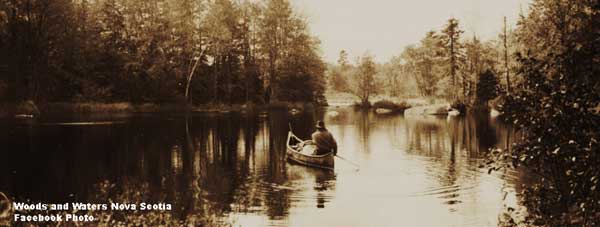 A lengthy back and forth discussion on Woods and Waters Nova Scotia (WWNS) followed a post on WWNS about an article in the Chronicle Herald – Mill’s deal with province raises concern (Aaron Beswick for Chronicle Herald, May 25, 2018). (See also the May 28 post about it.)
A lengthy back and forth discussion on Woods and Waters Nova Scotia (WWNS) followed a post on WWNS about an article in the Chronicle Herald – Mill’s deal with province raises concern (Aaron Beswick for Chronicle Herald, May 25, 2018). (See also the May 28 post about it.)
To view the discussion on WWNS (Facebook page), search for or scroll down to the post on May 26, 2018 “Mills deal with province raises concern” introduced with the statement “… basically the province is paying them to cut the wood….”
I have placed a copy of the discussion at the bottom of this post; I will update it if there are more responses on WWNS.
The question that calls for a direct, unambiguous answer: does DNR take in more in stumpage fees from Port Hawkesbury Paper than it puts out to manage the crown lands?
It appears not, based on the Chronicle Herald article which reports that “In 2017 Port Hawkesbury Paper paid $3.1 million in stumpage fees to the province and was paid back $4.4 million for silviculture work.”
In the discussion on WWNS, MM suggested that “there is more revenue from other products that isn’t being accounted for because that stumpage is being paid by a third party.”
So what about it NSDNR/PHP? Can you clarify if and how the Crown benefits financially from PHP’s harvests on Crown lands?
The statement NSDNR gave to Aaron Beswick is hardly illuminating, except to suggest NSDNR is justifying the sweet deal on other grounds:
For its part, the Department of Natural Resources provided a written response.
“Governments, in reaching negotiated licensing agreements with forestry companies, consider much more than earnings from stumpage fees paid by the company to the Crown,” reads the statement.
“The province also considers the benefits a given company provides Nova Scotia such as: GDP, labour, income, jobs, and general revenue. Forestry in Nova Scotia provides about 11, 500 jobs in total, with an economic impact over $2 billion, in 2015.”
According to its own figures Port Hawkesbury Paper directly spends $170 million a year in Nova Scotia. It, like Northern Pulp in Pictou County, also provides a destination for low quality pulpwood that helps sustain the sawmilling industry.
Perhaps Premier McNeil, who campaigned against corporate welfare, would care to comment.
The defenders of Industrial Forestry always like to cite the 11,500 jobs, $2B but don’t mention that this is less than 2% of our GDP, that fisheries and tourism, two industries increasingly negatively impacted by industrial forestry, employ far more people. Also, that without Industrial Forestry (or with a more socially and environmentally responsible Industrial Forestry) we would still have a forest economy, and perhaps the sooner the day of reckoning the better.
Oh Oh…a rant is developing. I’ll stop.
————–
 Comments on Woods and Waters Nova Scotia
Comments on Woods and Waters Nova Scotia
(May 26 – May 29, 2018)
JM: without tax subsidies it couldnt survive…..thats the sad truth
DGP:The truth of the matter is that industrial forestry in Nova Scotia is not a net income earner, it is corporate welfare. They tell Trump to show his tax returns, we need the government and industry to come clean on the real cost/benefit of industrial forestry to Nova Scotia, including in that the degradation of forest capital.
MP: Rumour has it the NS government is using taxpayer $$ to pay trucking costs for (Crown land???) wood destined for NP and PHP. This can be quite expensive no doubt especially if coming from SWNS. Not sure if there is any truth to it. Just wondering if anyone can verify or deny. If true perhaps it is all above board and an accepted way of doing business. Inquiring minds would like to know.
RD:The $4m for silviculture would be a reimbursement from the government for work funded by the mill. DNR covers only a portion of the cost for all silviculture treatments carried out by all registered buyers with a silviculture program and the mill covers the rest. If they received $4m they likely spent a similar amount of their own money in the program for that year. Silviculture spending is based on the total volume of wood purchased by the mill not just crown stumpage. Using these two $ figures to claim DNR is paying them to cut wood is very misleading.
–WWNS to RD: DNR might be better advised to open the books rather than keep them closed under the veil of “privacy concerns.” All the secrecy does nothing to instill public confidence.
—RD:100% agree.
–DGP to RD: I get your point, but it still amounts to the government giving more $ to PHP than it gets back for allowing them to harvest trees from public lands, the silviculture having one purpose only which is to improve the forest for harvesting the next time around.
–MM to DGP: The mill doesn’t keep the silviculture funds, it pays that money out to get work done. It would be more appropriate to say that it costs more to grow pulpwood than it is worth on the market than it would be to say the mill gets their wood for nothing… also important to keep in mind that PHP harvests pulpwood and biomass, the two lowest value products in the forest. So stumpage rates paid by the mill compared to other licensees like WestFor would be lower.
–DGP to MM: Is it The Mill’s bottom line that is most relevant..? The way I see it is like this: The government has a fleet of used cars that it wants to sell, so it sells them to a car dealer for 3.1m$, but the car dealer figures they need 6m$ work to make them sellable for 5 m$. So the government says OK we will give you $4.4 million towards fixing them up. The car dealer puts in 1.6m$ so he has paid 3.1+1.6=$4.7 million, and gets $5m from selling which is 0.3m$ profit. The government/people of Nova Scotia gains 3.1-4.4=minus $1.3 m. Who got the better of the deal? I am trying to understand the economics of it; I am not saying I am right, only this is the way it looks to me. Any clarifications appreciated! Perhaps there are “other factors”. Ok, lets see the full accounting.
–RD to DGP: DGP you’re doing math but only using part of the equation though. The $4.4m is a reimbursement for their whole program. It’s based on how much wood they bought from both crown and private. You would need to know how much was paid to private landowners as well. Don’t forget, the mill isn’t keeping the silviculture dollars, it is all paid out to the contractors who do the work.
–DGP to RD: I am looking at this from the perspective of a tax payer and “a co-owner” with other Nova Scotians of the Crown land, and the simple question is – are we paying our more for management of this Crown land (to improve future harvests) than we are taking in from stumpage fees, so it doesn’t matter whether PHP keeps the $ or not.
–MM: the lack of transparency doesn’t help anymore than making leaps of logic based on incomplete data
–WWNS: For what it’s worth to the conversation: https://novascotia.ca/natr/library/forestry/reports/FULA-Nov9-2012.pdf
— MM: For a good comparison, see the Medway Community Forest Agreement, which includes stumpage rates at the time of signing http://www.medwaycommunityforest.com/wp-content/uploads/2015/02/Medway-Operating-Agreement-DNR-FINAL-2015-01-30.pdf
— WWNS: Thanks. Nothing has been redacted. Full disclosure – that’s refreshing
— MM: Increased accountability and transparency are just two of the many benefits that Community Forestry offers compared to status quo crown tenure, as well as better multi-use management, higher levels of ecological stewardship and more local benefits.
— MM to DGP: I don’t think we’re seeing all the relevant numbers. PHP uses two products, softwood pulpwood and hardwood biomass (sold to NSP in return for steam). How many PHP cutblocks have you visited that only have two product sorts on the landing? You may have never visited a PHP cutblock so I’ll tell you the answer – probably none. In the 2W zone where I work, as much as 40% of the volume is from off species/products. If you’ve ever read PHP’s FULA you’d know that PHP is responsible for third party supply agreements for the rest of this volume. So I suspect there is more revenue from other products that isn’t being accounted for because that stumpage is being paid by a third party. [Bolding is mine]
–DGP to MM: “So I suspect there is more revenue from other products that isn’t being accounted for because that stumpage is being paid by a third party.” OK…Will NSDNR or PHP please enlighten us all? (Ideally, an independent 3rd party would investigate and report, but we’ve prob. worked that one over now as we wait for the report from the Independent Review.)
DW: Good on the mill for the amount of silviculture work they are doing to get that amount reimbursed
– WWNS: What does the cutting of old growth forest fall under?
– DW: Harvesting
– WWNS: Let me re-word the question Your Honour. Is it “good on the mill” as well for cutting old growth hardwood and burning it for biomass?
– DW: Biomass is green energy because governments in Canada don’t want to burn coal any more. Wind and solar can’t produce enough. So likely more biomass will be needed to energize the province and more old and young trees will be needed to feed the boilers so we have electricity. My opinion coal is the better option used with new technologies to clean the emissions and the trees are still standing to absorb the carbon
–DGP: Like the $ accounts, PHP/NSPI won’t come clean on the composition of feedstocks for the biomass boiler..which determines whether or not they are actually “Green Energy”…Baed on what I can surmise about the feedstocks, the PHO/NSPI biomass plant is far from carbon neutral and is worse than coal. So I agree with you that ” coal is the better option used with new technologies to clean the emissions and the trees are still standing to absorb the carbon”
–GO: If you want to know what the subsidies are, look at the books for the overall picture and don’t break out each specific detail in the beginning. Here are the books in New Brunswick (thanks to DM).
Dept. of Natural Resources Annual Reports
2011-2012
Page 2: The department’s total expenditures for the 2011-12 fiscal year were $117,506,500. Revenues collected by the department during the same year totalled $105,462,600.
Department had a loss of just over $12 million
2012-2013
Page 2: The department’s total expenditures for the 2012-13 fiscal year were $108 201 900. Revenues collected by the department during the same year totaled $80 785 600.
Expenditures $108 201 900 Revenue $80 785 600
Loss over $27 million
2013-2014
Page 16 – 17
Total Expenditures Actual $103,626,800
Total Revenue Actual $84,501,300
Loss over $19 million
2014-2015
Page 17
Total Expenditures Actual $100,876,000
Total Revenue Actual $87,471,300
Loss over $13 million
AF: siliculture rates have not gone up in the 20+ years i have been working this is unfair to the skilled and hard working people doing this work i would also say the quality of the work being done has gone down to compinsait for the lack of funds
————-
Thanks to MP for hosting constructive, moderated discussion of forestry issues on WWNS

